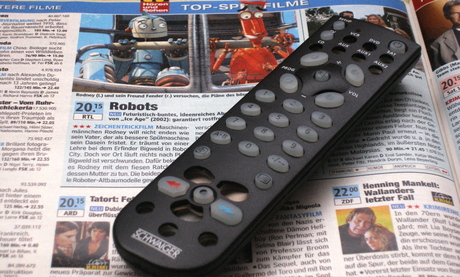
>>> Fwd >>>
Der Dokumentarfilm »Weizenbaum. Rebel at Work« wird auf der 13. GI-Fachtagung »Informatik und Schule – INFOS 2009« an der Freien Universität Berlin aufgeführt. Gezeigt wird der Film an der FU am 21. September 2009 um 18:00 Uhr im Hörsaal 1a der Rost-/Silberlaube, Habelschwerdter Allee 45, Berlin-Dahlem; im Anschluss findet eine Diskussion mit den Filmemachern statt. Der Film gehört zur Eröffnung der Konferenz, die ihr 25-jähriges Bestehen in Berlin begeht. Und er passt zum diesjährigen Motto: Zukunft braucht Herkunft.
Der 80-minütige Dokumentarfilm von Silvia Holzinger und Peter Haas porträtiert den deutsch-amerikanischen Informatikpionier und Gesellschaftskritiker Joseph Weizenbaum. In Berlin geboren, verließ Joseph Weizenbaum Deutschland 1936 und kehrte nach über 60 Jahren dorthin zurück. Der Film ist zugleich die erzählte persönliche Lebensreise des 85-jährigen „Rebellen“ und die Geschichte einer Jahrhunderterfindung, die des Computers.
“Der Film eröffnet gleichsam unsere Konferenz, die ihr 25-jähriges Bestehen in Berlin begeht. Er passt zum diesjährigen Motto: Zukunft braucht Herkunft” sagt Bernhard Koerber, Leiter der Tagung vom Fachbereich Erziehungswissenschaften und Psychologie, der die Filmemacher an die Freie Universität Berlin eingeladen hat.
Von Joseph Weizenbaum heißt es, er habe das Geschichtenerzählen in die Wissenschaft zurückgebracht. Im Film erzählt der alte Herr, der unter Informatikern zur Kultfigur geworden ist, sein Leben in Anekdoten und Exkursen. Er berichtet, wie er zum Professor am renommierten Massachusetts Institute of Technology ernannt wurde und wie es zu »ELIZA« kam, seinem wohl bekanntesten Beitrag auf dem Gebiet der Informatik. Der Zuschauer erfährt auch sehr Persönliches über den Gesellschaftskritiker und nimmermüden Mahner.
»Wir durften unseren Film bislang an mehr als 40 Orten präsentieren. Mit unserem Digitalen Kino in der Hochschule knüpfen wir an eine alte Tradition an und verstehen uns als Kulturbrücke zwischen Wissenschaft und Gesellschaft! Der Film hat seinen Weg in unzählige Schulen, Hochschulen und Medienzentren gefunden«, so Silvia Holzinger und Peter Haas, die für den unabhängig produzierten Film 2007 den Wolfgang von Kempelen Preis für Informatikgeschichte erhielten.
Die Veranstaltung findet bei freiem Eintritt statt, und ausdrücklich lädt die Freie Universität auch interessierte Zuschauer ein, die nicht an der Tagung teilnehmen.
Die Website zum Film bietet viele zusätzliche Materialen zum Download: www.ilmarefilm.org.
Weitere Informationen
<<<<
mehr auf mprove
Month: September 2009
Remote TV A11Y
This article is about reducing complexity with a knife, scissors, and some tape. These tools already indicate that I am talking about real life! Well, in fact you can cut all the wires of your power adaptors to simplify your life, but I do not recommending this right now. The problem at hand is a TV remote — I can hear your aarghs! Too many remote controls with too many functions, too tiny buttons, too easy to get lost, confusing labels and to sum it up: not suited to the task. My user population is an 80-yrs old lady with a telly hooked up to the cable; no special equipment like VCR, DVD, AUX 1-3 or SAT. Not to mention HD recorders, or TiVO with timeshift functionality. In my opinion it is even difficult for an educated engineer to use any remote control properly, but at 80 years you come from a totally different background to say the least, and your mental abilities are no longer at 100%. Usage errors are frequent — and the concept of Undo or Home is not available.
As said, my approach reduces the likelihood of user errors by making dangerous actions impossible to trigger:

http://www.23hq.com/mprove/photo/4903842
I find my design also superior to the competition because in terms of robustness you cannot remove the paper shield by accident.
 (also http://om.ly/Ipvj)
(also http://om.ly/Ipvj)
Other special remote controls aim to address a limited eyesight of the user by making everything larger:

http://www.23hq.com/mprove/photo/4903784
They shouldn’t have stopped here. Clear wording is preferred. But this is no news if you are familiar with accessibility guidelines. On the other hand, this is the first remote that offers a function to call a taxi (CAB) — I call that a unique selling point!
I suppose different shapes of buttons would also be a good idea, because haptic feedback becomes more important if you cannot see so well anymore; or if it’s quite dark in your living room with the home entertainment system. Though in the example above, channel and volume controls are too similar to get used to without taking a look all the time.
[originally published as a User Experience Forum Newsletter #28 | Join Xing]
service design is…

service design is interactive design meets industrial design meets advertising meets interior design meets graphic design meets sequential art. An interview with Pater Fossick by Paula Wallace.
/via Matthias Schrader